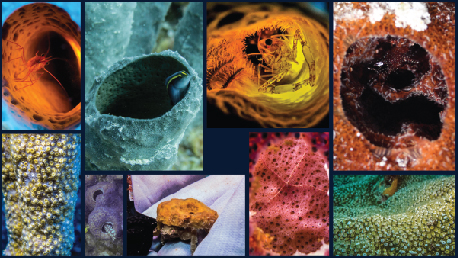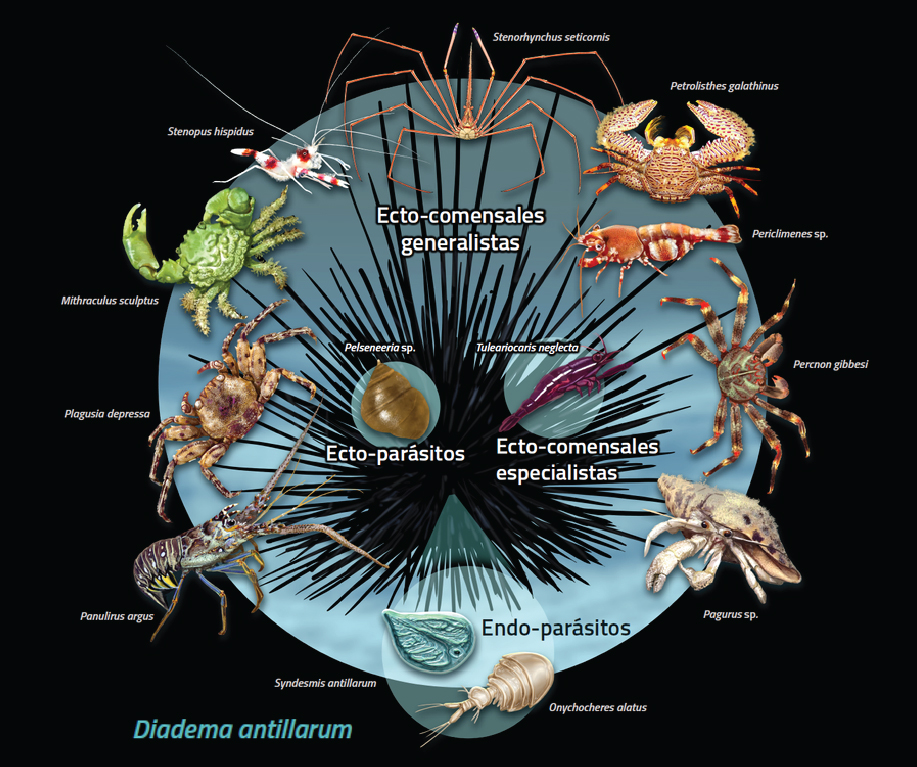
Welcome!
Marine species interactions is a project that arises from the need to understand the different processes and patterns that are behind the establishment of symbiotic relationships in coastal and marine environments. Our research line is focused on interactions ecology, networks ecology and interactions biogeography.
The main questions we seek to answer are, What type of interactions are we observe? What species have a generalist or specialist relationship? What is the importance of certain groups of organisms within the interaction network? What is the relationship between both interaction diversity and species diversity?
So far, our studies are focused on the American Atlantic Ocean, but we are willing to broaden our horizons.
Stay in touch
Relevant
Frontiers in Marine Science
The importance of home cleaning: Burrow and sediment transport by alpheid shrimps provides a competitive advantage to their host anemones
Pérez-Botello, AM et al. (2021)
Biodiversity Data Journal
Sponge dwelling-fauna: a review of known species from the Northwest Atlantic coral reefs.
Pérez-Botello, AM. & Simões N (2021)
Juego de datos interactivo
Sponge dwelling-fauna from the Northwestern Atlantic Ocean: a bibliographic records database.
Pérez-Botello, AM. & Simões N
Recent posts
Juego de datos
Sponge dwelling-fauna from the Northwestern Atlantic Ocean: a bibliographic records database.
Pérez-Botello, AM. & Simões N
Juego de datos
Paguroidea-Mollusca-Interactions V1.0
Cervantes, G
Juego de datos
Echino-Interactions V3.0
Soleto-Casas, RC & Simões, N
Global Coral Reef Week
Callyspongia aculeata dwelling-fauna in Cayo Arcas reef
Pérez-Botello, AM. & Simões N (2020)
5th WCMB
Guest-host interactions as diversity drivers in coral reefs
Pérez-Botello, AM et al (2020)
Our projects
Sponge-dwelling fauna
Fauna asociada a esponjas
This project focus on the biological story behind the sponges' associated fauna. Our objectives are: (1) document the involved organisms, (2) classify the interaction's type, and (3) analyze the structural importance of each species inside the interaction network.
Responsible: Antar Mijail Pérez Botello y Nuno Simões
Contact: antarmijail@comunidad.unam.mx
Status: Active

Echinoderm symbionts
Fauna asociada a equindermos
This project pursuit the description of ecological processes behind echinoderm-symbiont relationships. Our objectives are: (1) Integrate an updated and standardized database of echinoderms associated fauna reports (2) identify information gaps and (3) analyze the distribution and recurrence patterns of these associations.
Responsible: Rosa Carmen Sotelo Casas y Nuno Simões
Contact: rosacarmensotelocasas@gmail.com
Status: Active

Sessile cnidarians associated fauna
Fauna asociada a cnidarios sésiles
This project aims to analyze the type of interactions present in sessile cnidarians, such as anemones and corals.
Responsible: Ricardo González, Antar Mijail Pérez Botello y Nuno Simões
Contact: ns@ciencias.unam.mx
Status: Soon

Abstract
Guest-host interactions as diversity drivers in coral reefs
Pérez-Botello, AM; Sotelo-Casas, RC ; González-Muñoz R, Dáttilo W; Simões N
Despite being often ignored, the diversity of ecological interactions is one of the main facets of biodiversity. At coral reefs, the guest-host interactions have been recognized as an important speciation mechanism and structuring of the biodiversity present in this underwater ecosystem. The present work analyses the organization of the interaction networks involving three major host groups: cnidaria, echinoderms, and sponges, present at the American Tropical coral reefs. These host organisms share a particular characteristic, they all provide shelter and food sources to a wide range of sessile and mobile animals. Specifically, we describe the organization of the interaction network and the roles of some individual species, measuring the Nestedness (i.e., the extent to which the interaction partners of one species present a subset of the interaction partners of another species), the Modularity (i.e., the propensity of different subsets of species in the network to interact more frequently with each other than with the rest of the species in the network) and the centrality (i.e., structural importance of a species in the network). With this approach, we model the importance of guest-host interactions in maintaining biodiversity and define which species could be keystones in the American Atlantic coral reefs.
Abstract
Callyspongia vaginalis dwelling-fauna in Cayo Arcas coral reef.
Pérez-Botello, AM; Simões Nuno
The tubular sponge Callyspongia vaginalis is a solitary and dominant organism in the Gulf of Mexico and the Caribbean Sea coral reefs. Previous studies suggest the sponge’s aggregations will form animal forests, shaping habitats, and providing three-dimensionality to the reefs. The main objective of this work was to describe the relationship between the guest's symbiont diversity with sponge complexity. Using a photogrammetry process, the sampled sponges were digitized. The complexity was measured with an index that summarizes the digital sponge morphological characteristics. The host species changes were analyzed in two scales: local and individual. All the dwelling fauna was identified at the lowest taxonomic level. The correlation between complexity and species richness is positive, an increase in complexity means an increase in species number. In conclusion, the potential to host species was directly related to the sponge heterogeneity. This process could be mediated by colonization-dispersion cycles and refuge competition.
Citation: Pérez-Botello, AM. & Simões N (2020). Callyspongia aculeata dwelling-fauna in Cayo Arcas reef. Global Coral Reef Week. Remote Meetings to Connect Coral Reef Scientists Around the World















